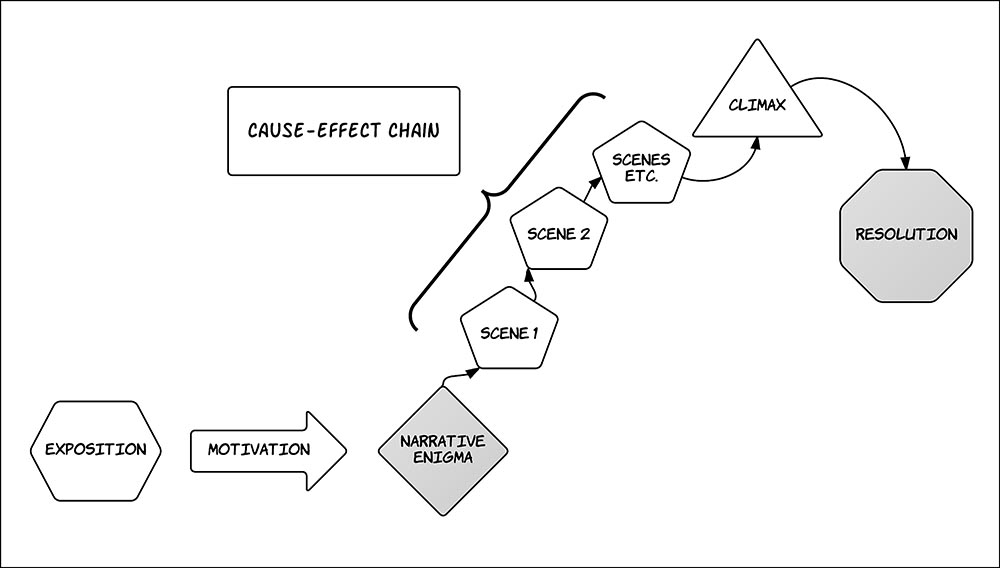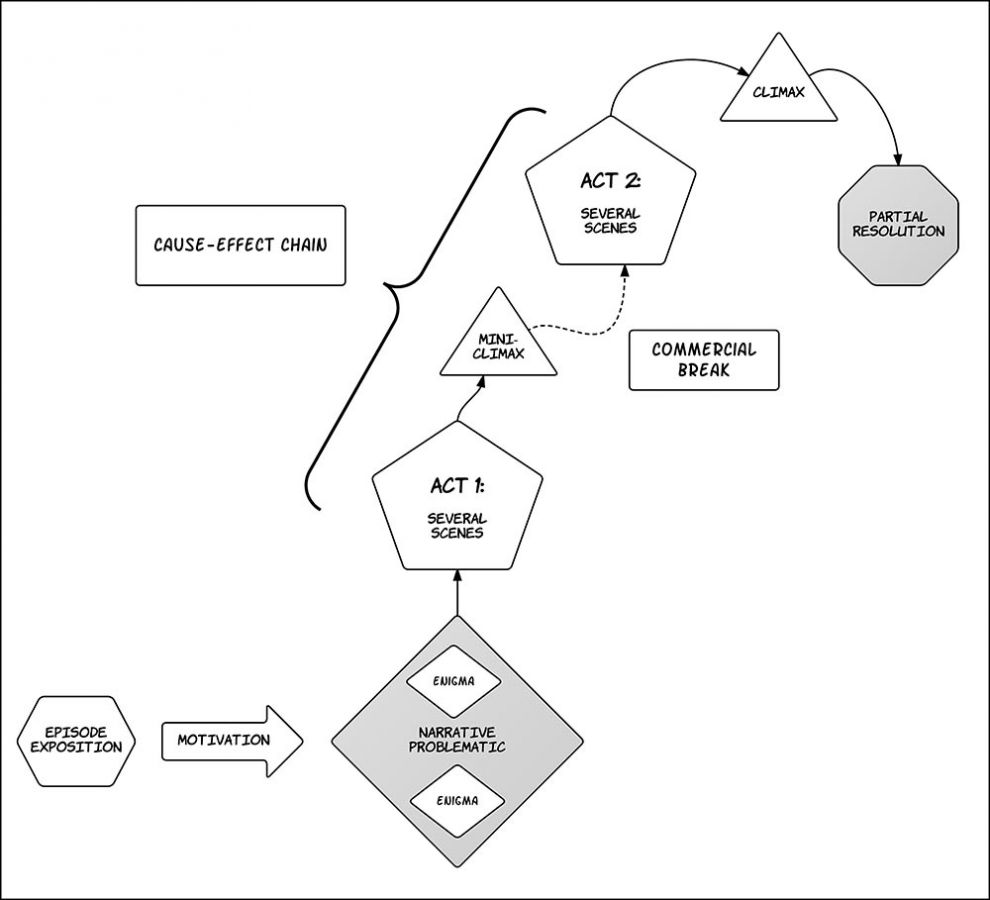|
|
| Line 1: |
Line 1: |
| − | =="Televisuality and the Resurrection of the Sitcom in the 2000s"== | + | ==Classical Hollywood cinema== |
| − | <gallery mode="packed" heights=200px> | + | <gallery mode="packed" heights=600px> |
| − | File:Table 5.3-resized.jpg|alt=Television Style, table 5.3|''Television Style'', table 5.3 "Multiple-camera and Single-camera Schemas," full table. | + | File:Narrative Structure - Classical Film.jpeg|alt=Diagram of classical narrative structure.|''Television'' Figure 3.6 The rise and fall of the narrative action in classical film. |
| − | File:Table 5.3 part 1 Cinematography.jpg|alt=Television Style, table 5.3|Table 5.3: Cinematography.
| |
| − | File:Table 5.3 part 2 MeS and Editing resized.jpg|alt=Television Style, table 5.3.|Table 5.3: Mise-en-Scene and Editing.
| |
| − | File:Table 5.3 part 3 Sound and Misc resized.jpg|alt=Television Style, table 5.3.|Table 5.3: Sound and Miscellaneous.
| |
| − | </gallery>
| |
| − | <gallery mode="packed" heights=400px>
| |
| − | File:Mindyproject 20131112qq00 00 55qq00040.jpg|alt=The Mindy Project screenshot.|Morgan, Mindy, Cliff, and Yana (from left).
| |
| | </gallery> | | </gallery> |
| | | | |
| − | View a scene from ''The Mindy Project'' (see Blackboard and [http://tvcrit.org/Classes/Jbutler/BUI301/MindyProject_20131112/index.html screenshots online]).
| + | Does ''Always Be My Maybe'' fit the classical implementation of: |
| | + | |
| | + | #Single protagonist |
| | + | #Exposition |
| | + | #Motivation |
| | + | #Narrative enigma |
| | + | #Cause-effect chain |
| | + | #*''Story time'' versus ''screen time''--in terms of duration and order |
| | + | #Climax |
| | + | #Resolution |
| | | | |
| − | *'''Table 5.3''' in "Televisuality and the Resurrection of the Sitcom in the 2000s" (see above) lists elements of the "single-camera televisual schema".
| + | ==The television series== |
| − | **How many of those single-camera elements do you see in ''The Mindy Project'' scene? Each group will account for one or two groups of elements (click a thumbnail above to enlarge it):
| |
| − | **#'''Group 1:''' cinematography
| |
| − | **#'''Group 2:''' mise-en-scene
| |
| − | **#'''Group 3:''' editing
| |
| − | **#'''Group 4:''' sound ''and'' "miscellaneous"
| |
| | | | |
| − | <gallery mode="packed" heights=400px> | + | <gallery mode="packed" heights=600px> |
| − | File:Table5.6ATelevisualContinuum.jpg|alt=Television Style, table 5.6 "A Televisual Continuum".|''Television Style'', table 5.6 "A Televisual Continuum". | + | File:Fig03-12 TV Series Narrative Structure - rendered.jpg|alt=Diagram of series-TV narrative structure.|''Television'' Figure 3.12 Linear-TV series' narrative structure must accommodate commercial interruptions and allow for a repeatable narrative problematic. |
| | </gallery> | | </gallery> |
| | | | |
| − | *'''All groups:''' '''Table 5.6''' from the essay outlines a "televisual continuum"--ranging from ''very'' televisual (''The Simpsons'') to not televisual at all (school-play recordings).
| + | Break down the "The Vartabedian Conundrum" episode from ''The Big Bang Theory'' (December 8, 2008). Number each scene and provide a ''brief'' description of it. |
| − | *#What does the term "televisual" mean--as conceived by John Caldwell (see p. 175)?
| + | *How many scenes does it have? |
| − | *#Where does ''The Mindy Project'' fit on the continuum? Table 5.6 puts ''The Honeymooners'' in the second category, ''The New Adventures of Old Christine'' ([[Editing: Multiple Camera Mode (Discussion)|which we discussed three weeks ago]]) in the third category, and ''Scrubs'' in the fifth category.
| |
| − | *#Where would you place ''The Office'' (see Ethan Thompson's and Brett Mills's discussion of comedy ''vérité ''; p. 214?
| |
| − | | |
| − | ==''Television: Visual Storytelling and Screen Culture''==
| |
| − | #'''Which stylistic approach does Butler's essay take?'''
| |
| − | #*Jalen, Emily, and Stephen had the best response:
| |
| − | #**Our group came up with that it could be a blend of all four!
| |
| − | #**Overall, it's more analytical, but there are some moments when you would give historical context (the laugh track for example. you discussed how tv originated as a "spin-off" of radios so it was more audio-focused in the beginning but it's slowly advancing to be more visual-focused). That gave historical context as to why shows needed the laugh track to be successful until a certain point in time.
| |
| − | #**It becomes more descriptive when breaking down scenes, like ''the New Adventures of Old Christine'' scene, shot by shot.
| |
| − | #**Evaluative is the least we found.
| |
| − | | |
| − | ===Questions ''not'' covered in class===
| |
| − | #'''All groups''': Explain how the textbook defines the term "style" in your own words.
| |
| − | #'''Group None:''' Explain the work of "evaluative" and "descriptive" stylisticians. How might they approach ''The Mindy Project''?
| |
| − | #'''Group 1:''' Explain the work of "analytic" stylisticians. How might they approach ''The Mindy Project''? Be ready to define the following purposes or "functions" of style discussed in the textbook.
| |
| − | #*symbolize
| |
| − | #*decorate
| |
| − | #'''Group 2:''' Explain the work of "analytic" stylisticians. How might they approach ''The Mindy Project''? Be ready to define the following purposes or "functions" of style discussed in the textbook.
| |
| − | #*persuade
| |
| − | #*hail or interpellate
| |
| − | #*differentiate
| |
| − | #'''Group 4:''' Explain the work of "historical" stylisticians. How might they approach ''The Mindy Project''? Be ready to define these terms: "craft practices" and "schemas."
| |
| − | | |
| − | == Bibliography ==
| |
| − | #Butler, Jeremy G. ''Television: Visual Storytelling and Screen Culture''. NY: Routledge, 2018.
| |
| − | #Butler, Jeremy G. "Televisuality and the Resurrection of the Sitcom in the 2000s," in ''Television Style'' (NY: Routledge, 2010), 173-222.
| |
| | | | |
| − | ==External links==
| + | Does the episode contain the conventional elements of a TV series? What are the key differences between its narrative structure and that of a classical film? |
| − | *[https://www.tvstylebook.com/ ''Television Style'' official homepage]
| + | #Multiple protagonists |
| − | *[https://tvcrit.org/Classes/Jbutler/BUI301/MindyProject_20131112/index.html ''The Mindy Project'' screenshots]
| + | #Exposition |
| − | *[https://criticalcommons.org/Members/jbutler/clips/blending-multiple-camera-and-single-camera/ Hybrid mode of production] in ''How I Met Your Mother''
| + | #Motivation |
| − | *[https://tvcrit.org/Classes/Jbutler/BUI301/NewAdventuresofOldChristine/ ''The New Adventures of Old Christine'': screenshots]
| + | #Narrative problematic |
| − | *[https://tvcrit.org/Classes/Jbutler/BUI301/NewAdventuresofOldChristine/Table%20502_OldChristine.pdf ''The New Adventures of Old Christine'': découpage]
| + | #Cause-effect chain |
| | + | #Climax |
| | + | #Resolution? |
| | | | |
| − | [[Category:BUI301]] | + | [[Category:BUI301F2022]] |
| − | [[Category:BUI301 Discussion]] | + | [[Category:BUI301F2022 Discussion]] |
| − | [[Category:JCM311]]
| |
| − | [[Category:JCM311 Discussion]]
| |

